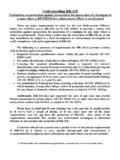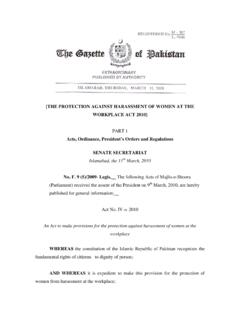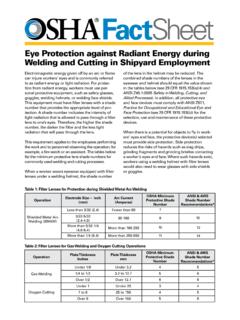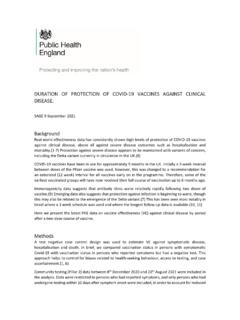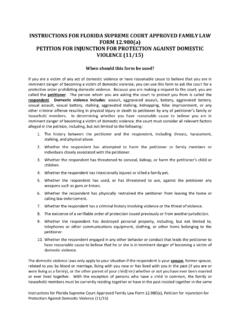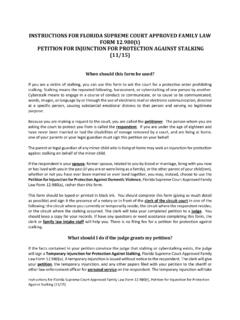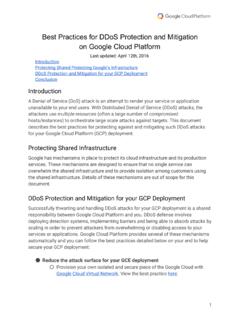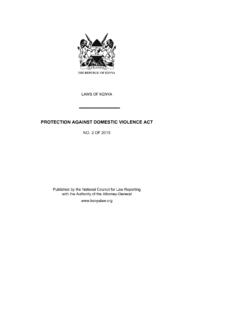Transcription of Guide to Protection of Steel Against Corrosion
1 Infosteel Guide to Protection of Steel Against Corrosion Indoor and outdoor structures 1st edition: May 2012. Value 10 EUR. 1 Introduction. Environmental regulations Attention is drawn to the fact that the environmental regulations on Foreword Corrosion -resistant products are constantly becoming stricter and that they depend on the location where they are used. It is up to the different This Guide has been drawn up based on the following publications: participants to determine whether the systems used comply with the environmental regulations. ECCS Technical Committee 4 Surface Protection , Technical Note N 90, Surface Protection Guide for Steelwork in Building Interiors and Facades, First Edition (1997); Specific conditions ECCS Technical Committee 4 Surface Protection , Technical Note N 98, Surface Protection Guide for Steelwork exposed to Atmospheric In order to choose the optimal Protection system, for each project account Environments, First Edition (1998).
2 Must be taken of the specific conditions that apply to the structures (indoor or outdoor application, visible or hidden structure, accessibility, etc). The information from the above publications has been updated taking into account the development of the standards and the state of technology currently applied in the Belgian and Luxembourg markets. 2. Atmospheric Corrosion This Guide describes solutions for protecting Steel structures Against Corrosion , irrespective of whether these structures are located inside Atmospheric Corrosion plays a role in structures which are neither buried nor buildings or whether they are exposed to the outside air. The Guide has been submerged in a liquid (usually water). The Corrosion of buried or submerged prepared by a working group consisting of experts in the field of Protection of structures is dealt with in Steel Against Corrosion and those working with the following organizations: The risk of atmospheric Corrosion and the rate at which this Corrosion Infosteel ( ); occurs are primarily dependent on the following parameters: VOM vzw.
3 The Belgian association for the relative humidity of (inside or outside air) where the Steel surface technologies of materials ( ); structure is located;. the risk of condensation (depending on the relative humidity, the Stichting Zinkinfo Benelux ( ); temperature of the Steel and the speed at which the air is moving);. the concentration of corrosive pollutants (gases, solids or liquids), the Mobility and Public Works' department of the such as sulphur dioxide, acids, alkalis or salts. Flemish Region ( ). The solutions for Protection Against Corrosion for the corrosivity class C2 to C5 (atmospheric Corrosion ) are described in the central table of this General document. The purpose of this Guide is to provide guidance to all participants in the construction industry (clients, architects, consulting engineers etc.)
4 Involved in the design, the actual construction, the maintenance and the renovation of 3. Exceptional cases Steel structures. There are a number of solutions recommended for Corrosion Protection , based mainly on the corrosivity class (C1 to C5). Corrosivity class C1. The anticorrosive systems described in this document are based on reference standards or codes of practice. Corrosivity class C1 corresponds to the neutral interior atmosphere of a dry and heated building. In this class non-visible elements (lowered This Guide contains a non-exhaustive list of existing Corrosion Protection ceilings, attics, etc.) require no anticorrosive treatment, except some systems. Only the most frequently used and the most appropriate solutions constructions that are built into the masonry (see , 2nd situation).
5 Are proposed. It is possible that other acceptable solutions exist for specific projects that are not described here. When elements in a class C1 interior atmosphere are visible, for aesthetic reasons and with a view to easy cleaning, it may however be desirable to provide a minimum level of Protection , such as the 2/2-system. Innovative systems It should be pointed out that a dry and heated building where no neutral New Corrosion Protection systems are constantly being developed and put on atmosphere prevails (presence of corrosive gases or chlorides) falls under the market. That those systems are not included in this Guide says nothing a higher corrosivity class. about their performance. The explanation is that these systems are continuously under development or that there are no existing practical guidelines for them.
6 Corrosion with buried or submerged 1st situation: the Steel structure is structures protected Against water from the outside With buried or submerged structures, the choice of an anti- Corrosion When the Steel structure is protected Against water from the outside, the system depends on a large number of parameters. This is a complex choice of the anticorrosion system is based on the corrosivity class that choice wherein a specialist should be consulted. These special situations corresponds to the interior atmosphere of the building. are therefore not dealt with in this Guide . This situation occurs in the following cases: COMMENTS: when the outer cavity leaf of the building is water tight (Figure 1a). The following parameters must be taken into account with buried when the Steel structure is protected Against water infiltration: - structures: chemical composition, water content, degree of soil aeration either by a layer of air of at least 40 mm (Figure 1b) - or by a and mechanical load.
7 Continuous, impermeable layer of material at least 25 mm thick With submerged structures account must be taken of the salt content (Figure 1c). and the chemical composition of the water and any cycles of immersion and drying (which are determining for the submerged zone, the transition zone and the splash zone). 2nd situation: the structure is possibly exposed to water from the outside. Structures worked into When there is a risk that the Steel structure is exposed to water from the the masonry outside, hot-dip galvanizing is a suitable Protection solution for an interior atmosphere of class C1 to C4. When Steel structure elements are located in the outer wall of a building and they are not fully visible or accessible, the choice of the anticorrosion system This applies for the majority of cases where the Steel structure directly can not always be based on the corrosivity class of the interior atmosphere of (Figure 2a) or indirectly (Figure 2b) comes into contact with the non- the building.
8 There are two possible situations. watertight outer cavity leaf of the building. >25 mm >40 mm a. b. c. Figure 1: the Steel structure is protected Against water from the outside (horizontal cross-section). a. Watertight outer cavity leaf b. Non-watertight outer cavity leaf - Presence of a layer of air c. Non-watertight outer cavity leaf - Presence of an intermediate layer in a watertight material a. b. Figure 2: the Steel structure is exposed to water from the outside (horizontal cross-section). a. Non-watertight outer cavity leaf - Steel structure in contact with the outer cavity leaf b. Non-watertight outer cavity leaf - Presence of an intermediate layer in a watertight material 4. Reference documents EN ISO 1461 : 2009 Hot-dip galvanized coatings on fabricated iron and Steel articles - Specifications and test methods EN ISO 2063 : 2005 Thermal spraying Metallic and other inorganic protective coatings - Zinc, aluminium and their alloys EN ISO 4628-3 : 2003 Paints and varnishes - Evaluation of degradation of coatings - Designation of quantity and size of defects, and of intensity of uniform changes in appearance * Part 3: Assessment of degree of rusting (ISO 4628-3:2003).
9 ISO 8501-1 : 2007 Preparation of Steel substrates before application of paints and related products. Visual assessment of surface cleanliness. * Part 1: rust grades and preparation grades of uncoated Steel substrates and of Steel substrates after overall removal of previous coatings ISO 9223 : 1992 Corrosion of metals and alloys Corrosivity of atmospheres - Classification EN ISO 12944 Paints and varnishes Corrosion Protection of Steel structures by protective paint systems Parts 1 to 4: 1998 * Part 1: General information Part 5: 2007 * Part 2: Classification of environments Parts 6 to 8: 1998 * Part 3: Design considerations * Part 4: Types of surface and surface preparation * Part 5: Protective paint systems * Part 6: Laboratory performance test methods * Part 7: Execution and supervision of paint work * Part 8.
10 Development of specifications for new work and maintenance EN ISO 14713 Protection Against Corrosion of iron and Steel in structures -- Zinc and aluminium coatings - Guidelines Parts 1 and 2: 2009 * Part 1: General principles of design and Corrosion resistance * Part 2: Hot-dip galvanizing EN 15773: 2009 Industrial application of powder organic coatings to hot dip galvanized or sherardized Steel articles [duplex systems]. Specifications, recommendations and guidelines GSB ST 663 International Quality Regulations for the Piecework Coating of Steel and Galvanised Steel Building Components Edition May 2011. Belgian code of practice Quality requirements for the industrial application of organic protective layers on intermittent hot-dip galvanized Steel (duplex- BPR 1197 duplex system).


